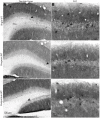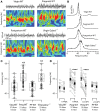Altered gamma oscillations during pregnancy through loss of δ subunit-containing GABA(A) receptors on parvalbumin interneurons
- PMID: 24062647
- PMCID: PMC3775147
- DOI: 10.3389/fncir.2013.00144
Altered gamma oscillations during pregnancy through loss of δ subunit-containing GABA(A) receptors on parvalbumin interneurons
Abstract
Gamma (γ) oscillations (30-120 Hz), an emergent property of neuronal networks, correlate with memory, cognition and encoding. In the hippocampal CA3 region, locally generated γ oscillations emerge through feedback between inhibitory parvalbumin-positive basket cells (PV+BCs) and the principal (pyramidal) cells. PV+BCs express δ-subunit-containing GABA(A)Rs (δ-GABA(A)Rs) and NMDA receptors (NMDA-Rs) that balance the frequency of γ oscillations. Neuroactive steroids (NS), such as the progesterone-derived (3α,5α)-3-hydroxy-pregnan-20-one (allopregnanolone; ALLO), modulate the expression of δ-GABA(A)Rs and the tonic conductance they mediate. Pregnancy produces large increases in ALLO and brain-region-specific homeostatic changes in δ-GABA(A)Rs expression. Here we show that in CA3, where most PV+ interneurons (INs) express δ-GABA(A)Rs, expression of δ-GABA(A)Rs on INs diminishes during pregnancy, but reverts to control levels within 48 h postpartum. These anatomical findings were corroborated by a pregnancy-related increase in the frequency of kainate-induced CA3 γ oscillations in vitro that could be countered by the NMDA-R antagonists D-AP5 and PPDA. Mimicking the typical hormonal conditions during pregnancy by supplementing 100 nM ALLO lowered the γ frequencies to levels found in virgin or postpartum mice. Our findings show that states of altered NS levels (e.g., pregnancy) may provoke perturbations in γ oscillatory activity through direct effects on the GABAergic system, and underscore the importance of δ-GABA(A)Rs homeostatic plasticity in maintaining constant network output despite large hormonal changes. Inaccurate coupling of NS levels to δ-GABA(A)R expression may facilitate abnormal neurological and psychiatric conditions such as epilepsy, post-partum depression, and post-partum psychosis, thus providing insights into potential new treatments.
Keywords: CA3 interneurons; GABAA receptors; delta subunit; gamma oscillations; neurosteroids; parvalbumin; pregnancy; tonic inhibition.
Figures








Similar articles
-
In vitro gamma oscillations following partial and complete ablation of δ subunit-containing GABAA receptors from parvalbumin interneurons.Neuropharmacology. 2015 Jan;88:91-8. doi: 10.1016/j.neuropharm.2014.09.010. Epub 2014 Sep 28. Neuropharmacology. 2015. PMID: 25261782 Free PMC article.
-
Early alterations in hippocampal perisomatic GABAergic synapses and network oscillations in a mouse model of Alzheimer's disease amyloidosis.PLoS One. 2019 Jan 15;14(1):e0209228. doi: 10.1371/journal.pone.0209228. eCollection 2019. PLoS One. 2019. PMID: 30645585 Free PMC article.
-
δ-Containing GABAA receptors on parvalbumin interneurons modulate neuronal excitability and network dynamics in the mouse medial prefrontal cortex.J Neurophysiol. 2025 Apr 1;133(4):1003-1013. doi: 10.1152/jn.00495.2024. Epub 2025 Feb 27. J Neurophysiol. 2025. PMID: 40013665 Free PMC article.
-
GABAA receptor modulation by neurosteroids in models of temporal lobe epilepsies.Epilepsia. 2012 Dec;53 Suppl 9:89-101. doi: 10.1111/epi.12038. Epilepsia. 2012. PMID: 23216582 Review.
-
Involvement of cortical fast-spiking parvalbumin-positive basket cells in epilepsy.Prog Brain Res. 2016;226:81-126. doi: 10.1016/bs.pbr.2016.04.012. Epub 2016 Jun 7. Prog Brain Res. 2016. PMID: 27323940 Free PMC article. Review.
Cited by
-
Increased Dendritic Branching of and Reduced δ-GABAA Receptor Expression on Parvalbumin-Positive Interneurons Increase Inhibitory Currents and Reduce Synaptic Plasticity at Puberty in Female Mouse CA1 Hippocampus.Front Cell Neurosci. 2020 Jul 9;14:203. doi: 10.3389/fncel.2020.00203. eCollection 2020. Front Cell Neurosci. 2020. PMID: 32733208 Free PMC article.
-
Neurosteroid Actions in Memory and Neurologic/Neuropsychiatric Disorders.Front Endocrinol (Lausanne). 2019 Apr 9;10:169. doi: 10.3389/fendo.2019.00169. eCollection 2019. Front Endocrinol (Lausanne). 2019. PMID: 31024441 Free PMC article. Review.
-
Diminished KCC2 confounds synapse specificity of LTP during senescence.Nat Neurosci. 2016 Sep;19(9):1197-200. doi: 10.1038/nn.4357. Epub 2016 Aug 8. Nat Neurosci. 2016. PMID: 27500406 Free PMC article. Review.
-
Additive effect of contrast and velocity suggests the role of strong excitatory drive in suppression of visual gamma response.PLoS One. 2020 Feb 13;15(2):e0228937. doi: 10.1371/journal.pone.0228937. eCollection 2020. PLoS One. 2020. PMID: 32053681 Free PMC article.
-
Ovarian cycle-linked plasticity of δ-GABAA receptor subunits in hippocampal interneurons affects γ oscillations in vivo.Front Cell Neurosci. 2014 Aug 11;8:222. doi: 10.3389/fncel.2014.00222. eCollection 2014. Front Cell Neurosci. 2014. PMID: 25157218 Free PMC article.
References
-
- Baude A., Bleasdale C., Dalezios Y., Somogyi P., Klausberger T. (2006). Immunoreactivity for the GABAA receptor alpha1 subunit, somatostatin and Connexin36 distinguishes axoaxonic, basket, and bistratified interneurons of the rat hippocampus. Cereb. Cortex 17, 2094–2107 10.1093/cercor/bhl117 - DOI - PubMed
MeSH terms
Substances
LinkOut - more resources
Full Text Sources
Other Literature Sources
Miscellaneous

